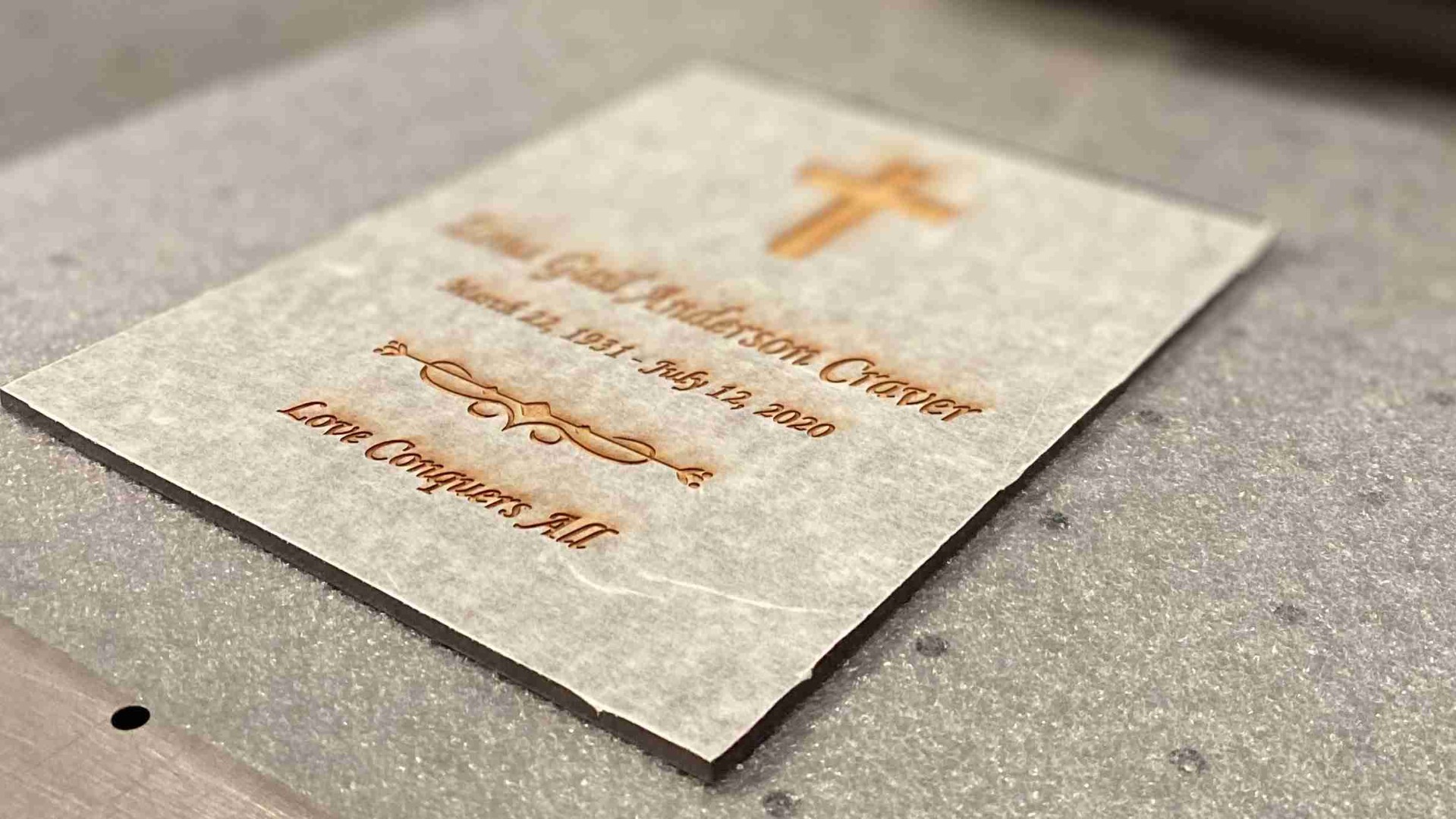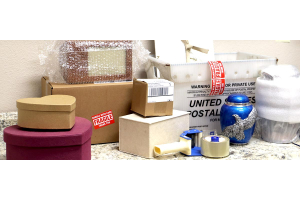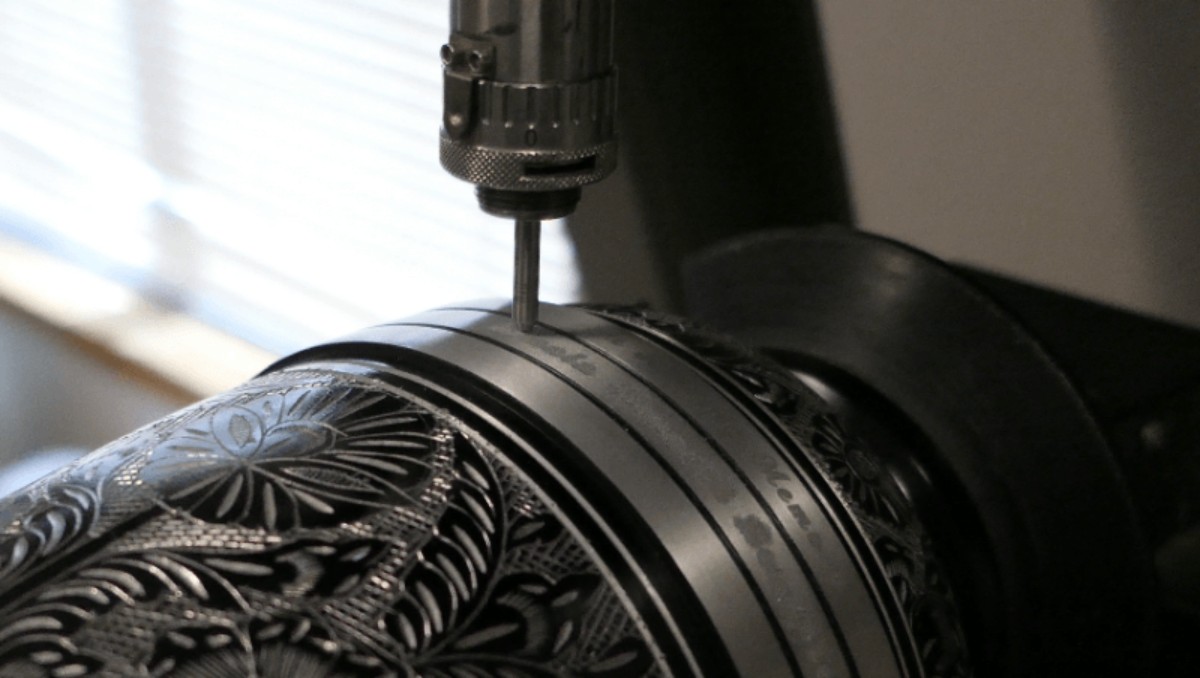
Every urn is special, and not just because of the loved one whose remains are inside it. Each one carries a message of love and long-term grief that families keep sending for as long as their memories last. Putting a message on the urn allows family members to indicate whose remains are kept in the space. In many cases, engraving also makes room for an interesting design or a few loving words about the person. These options make it easier for people to get an urn that feels personalized, as interesting and unique as the person honored by it. At In The Light Urns, we use a variety of methods to achieve the perfect sendoff, including a diamond drag machine, lasers and sand-blasting.
History of Engraving
In non-language forms, engraving dates back hundreds of thousands of years. Early humans carved lines and images into shells. Later, they did the same on bones or tusks. Working styles into metal didn’t come until much later. This is because metal is a harder surface that is more difficult to cut into. Most early forms of it are more like embossing. This describes a process of hammering a softer metal, like gold, into a shape from the other side. It creates a relief pattern. People got better at it over the centuries.
Modern engraving started with the concept of making a plate. This allowed artists who wanted to reproduce the same print again and again to engrave a design into metal, usually copper. This led to demand for more intricate designs, prompting a lot of the innovations we see today. These days, professional engravers can use hand tools to create a one-of-a-kind image or use a computer to achieve a consistent layout. In either case, it requires a great deal of precision and the ability to finish the surface so that it will not rust or chip.
Engraving vs. Etching
Although engraving and etching are similar, it’s important to understand that they aren’t the same thing. An engraved surface has had a portion cut, usually using a laser, diamond drag machine or sand-blasting. Etching uses a process to remove a layer from the surface. Etching can be done by lasers, acid or other burning techniques, depending on the material. Etching became popular during the Renaissance because it was easier for artists to develop as a skill. The way that it works means that etching tends to be much less precise and intricate in the final result.
Why Engrave on Cremation Urns?
For thousands of years, people have wanted to leave a memorial for their loved ones. In the millennia before groups of people developed a written language, they may have carved figurines or left other treasures in the places where they put a person’s final remains. Burial, even for ashes contained in an urn, is an important part of the grieving process for those left behind.
Absent unusual situations like plague, where people died too quickly to give them a defined burial place, almost every civilization has had a process for marking whose remains are kept here. Engraved words giving the person’s name, perhaps their family and a loving message, is a tradition going back centuries. Just as family members would request a name and dates on a headstone in a cemetery, people want to create a personalized message on an urn.
Diamond Drag Engraving
As one of the hardest stones, diamonds have been used for centuries as a method of cutting into stone, metal and other materials. Diamond drag engraving takes advantage of this strength to create an intricate and beautiful design with absolute precision. The steel component has a small piece of a finely cut and shaped diamond placed on the end. This provides the perfect surface to use in machine or hand-engraving.
The angle for the engraver depends on the material. Soft metals like gold or pewter need a wider angle. Otherwise, the tip will gouge deeply into the surface. Brass and aluminum can handle a more direct cut and a more precise line. After the process is complete, the engraver can oxidize the surface to make the engraved design show up in a darker color. This creates a beautiful contrast that feels perfectly natural.

Brass Urns and Medallions
Choosing urns that use the diamond drag process offers dozens of excellent options. For elegant simplicity, the Leaves of Peace Pewter Urn has a brass interior and a pewter finish. This style engraves up to four lines directly onto the urn. This process is most often used to create a lasting memorial, but can also add a hint of personalization to the surface. The Gone Fishing Brass Cremation Urn uses engraving to create a fish leaping out of water, directly on the brass.
Although many of our metal urns maintain their natural look, there are several that have rich colors added. The Ocean Lighthouse Cremation Urn has a metal surface handcrafted with the image of a beautiful lighthouse at sunset. It features a medallion with up to three engraved lines.
Laser Engraving
Lasers offer another technological innovation to get the exact image. People may think of lasers as a beam of light that causes a reaction. For this process, the laser uses heat to change the nature of the surface. It is a little like burning away a layer of material, usually wood but sometimes natural stone like marble. We also use it for engraved tags.
However, unlike using a branding tool, the laser is extremely precise and leaves no burn marks behind. It virtually makes the material disappear, leaving a visiblelayer underneath. The engraver can repeat the process more than once. This creates a sense of relief with multiple layers, or simply makes the result a little deeper and easier to see.
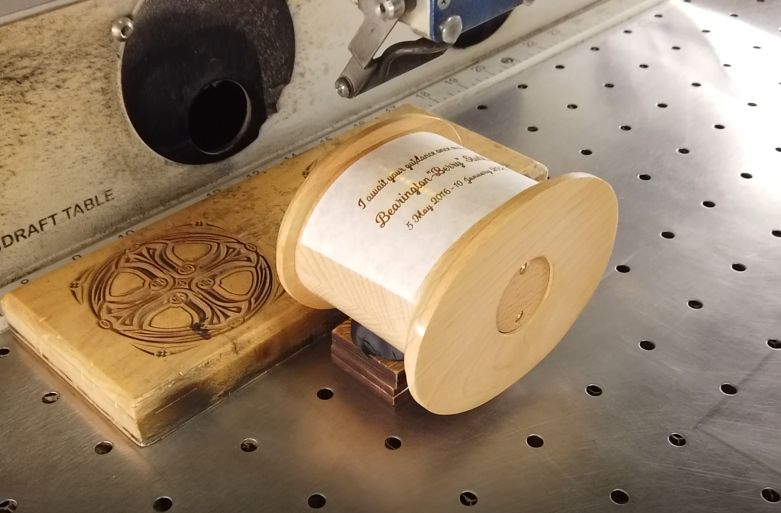
Color Fill
Using a laser does not necessarily change the color of the material underneath. The high heat does not create a burn mark on wood, although it can on wood that has a layer of lacquer. This means that the wood underneath may not look much different and the message not as easy to read without color. The color-filling process involves a very fine system of applying paint in a choice of colors, often black, white or a metallic hue. The best one provides an ideal contrast with the surface, which may be natural wood or a full-color picture printed directly onto the material.
Wood and Marble Urns
This process works best on wood urns, as well as some of our marble urns and engraved tags. For example, the Gray Wolves Art & Wood Cremation Urn features a realistic Polystone depiction of a mother wolf with her cub on a wood base with a black finish. The engraved lines create a beautiful contrast that coordinates with the wolves. The Purple Marble Adult Options Cremation Urn is natural marble, washed in a deep purple color. Up to three engraved lines in two colors make the message clear. Lasers create a clear image on engraved tags, which can also function as keepsake urns or cremation jewelry. The Baseball Dog Tag Blue Heart Key Chain Urn is made of stainless steel with a soft bronze finish, with engraved lines on the back of the urn.
Sand-Blasting
Unlike diamond drag or laser engraving, sand-blasting uses material to remove a thin layer from the surface. This method tends to be less precise, although it is still possible to get an excellent result. The design also may not last as long, particularly if it is placed outside and exposed to wind, rain and ice. However, it works well for urns that are too large to fit in the diamond drag machine, and for materials that wouldn’t be suited for laser engraving.
During the sand-blasting process, the engraver covers the surface with something like a stencil. They can then direct a steady stream of fine bits of sand at high speed. This erodes the surface quickly and expertly. Then, depending on the material, it can be oxidized or have color added for greater definition. Sand-blasting is a common approach for putting designs on materials like clay or glass.

Companion Urns
Companion urns tend to be much larger than a standard adult urn. This is because they are meant to hold the ashes of at least two adults, which is about 400 cubic inches. The Photo Heart Companion Brass Urn features a larger size and space for engraved lines on both sides, one for each person. Sand-blasting is also ideal for our pyramid-shaped urns, such as the Pyramid Brass Adult Urn. This urn has a larger base and is made of brass with a lovely, bright white finish.
Engraving for 3D Urns
The most customizable of our custom cremation urns, 3D urns feature tons of variety. Customers can get almost anything they can imagine, in a wide selection of sizes. This means that we use several different approaches to ensure that the engraved lines or images give a spot-on match. In many cases, we can build it into the 3D printing process. This involves taking a three-dimensional rendering of an image and building it from scratch using very fine layers of material. Powdered gypsum is the most common, but metals and wood are also available. If it’s important to add the engraving onto that material, it may be easiest to do it during construction. That way, it gives a perfect look with colors added after the fact. We can also use sand-blasting for our 3D urns, especially since many styles that customers choose are larger than the average urn.
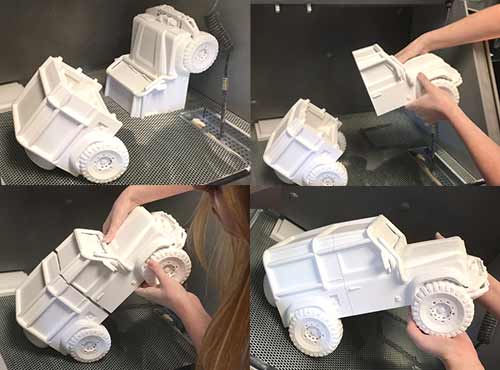
How to Choose a Font Face for Engraving
At In the Light Urns, we offer a variety of font styles and other options that customers can choose to make the urn more customizable. Although this might seem like a silly thing to worry about, the type of font matters a lot. Family members may be looking at the urn for decades. If the urn is meant to go in a public memorial, thousands of people may read it each year. Choosing the right one is a matter of opinion, but also practicality. There is a virtually unlimited number of fonts. They range from the most plain and straightforward to the most elaborate, with swirling curlicues all over the place. Families may want to test out the text in the font they choose and confirm that they can read it clearly. A touch of whimsy in a font choice is excellent, as long as almost anyone can determine what it’s supposed to say.
Braille Engraving
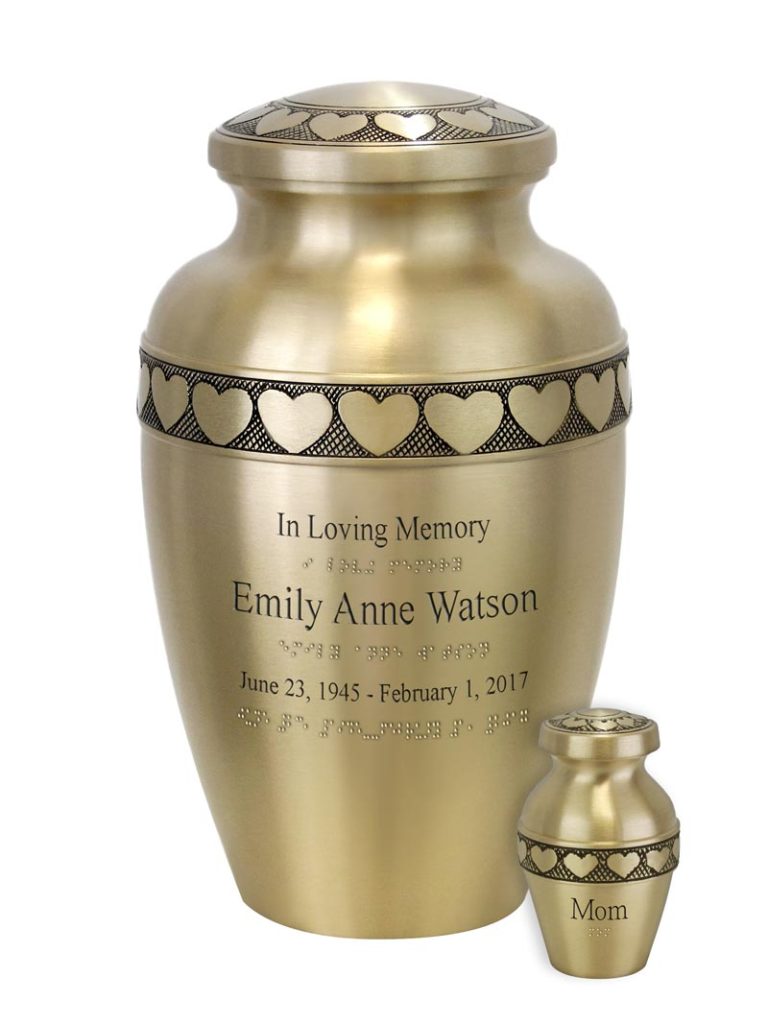
Adding a message to an urn can be a delight for anyone who sees it, and for many who cannot. Many of our urns can support a Braille engraving on the surface, in addition to the normal lines of text available for the urn. The Circle of Hearts Braille Cremation Urn is made of spun brass. We also offer this service for other materials, including the Hummingbird Stars Braille Cremation Urn and the Eagle Faith Isaiah 40:31 Braille Urn. Creating the raised bumps often involves removing layers of the surface surrounding them so that people can feel a raised relief. In some materials, including as a part of 3D printing, it can be done by adding material to a flat surface.
How to Clean an Engraving
Since many of our engraved urns are meant to sit in a spot for as long as family members want, maintenance is an important part of the decision. An urn that is reasonably simple to keep clean and free of dust is a wonderful home décor item that doesn’t add to family’s stress while they are grieving. Urns need special care when cleaning simply due to their contents, but also related to the material. Depending on the depth of the engraving, it may be necessary to clean dust out of the corners. Knowing how to clean it saves family members time and keeps the urn in better condition.
Metal
Most metals, like brass, pewter or stainless steel, are fairly easy to clean. If the engraved surface is not clogged with dirt, all families may need to do is to wipe it down once a month with a soft, damp cloth. If an engraved plate becomes very dirty, wiping it with a wet cloth with a drop of dish soap should clean it up quickly. It’s important not to dip the urn into water to clean it, especially if the engraved part has color. This can damage the urn and remove the color.
Silver
Silver urns and cremation jewelry require a little more care than the average metal urn. This is because silver can tarnish, and cannot tolerate the same kinds of cleaning products and surfaces. Anyone who buys a silver urn or cremation jewelry should invest in a polishing cloth designed specifically for sterling silver. Usually, gentle polishing should remove most of the tarnish. As a general rule, people should avoid rubbing directly on engraved parts of the urn, as this could rub away the color. Setting reminders to remove dust on a regular basis can eliminate most of these issues before they become a serious problem.
Wood
Most of our wood urns are polished to provide a smooth surface that is easy to wipe clean with a cloth. That said, they may require a little extra rubbing to remove dust if it accumulates over time. Like silver, families cannot use just any cleaning product on wood. Even natural products like salt or vinegar can scratch or warp the surface. Wiping with a slightly damp cloth, not wet, usually solves the problem.
Colored Engraving
Since the color in a laser engraving is added after the fact, it also needs special attention. Hard scrubbing or the use of abrasive cleaners can strip the paint or chip it. Generally, families should aim to keep it clean and dry. Using something small with a blunt, wood end like a toothpick or a cuticle stick can help get into the crevices. This makes it easier to remove dust and dirt without gouging the corners of the surface or chipping the paint.
Other Materials
Since we make urns in a variety of natural and biodegradable materials, families may need to know how to clean the engraved parts of those, as well. Anything that breaks down in water should stay dry if at all possible for above ground use. This includes urns made out of natural salt and sand. Those made of natural stone may be able to handle a damp cloth or gentle cleanser like dish soap. Periodic dusting is usually sufficient, particularly for urns made of non-metal materials.
Many loved ones long for an opportunity to send a final message to a person who has passed away. Even those who get the chance to say goodbye when they know it is forever would wish for one more moment. A message in an engraving on an urn is something that family members can see every time they look at the urn or feel it. The texture created by the process gives a durable, long-lasting appearance with a bright or dark color that highlights the words contained within. In many ways, it is one of the last and most important things that people can say to someone they will miss for the rest of their lives.
